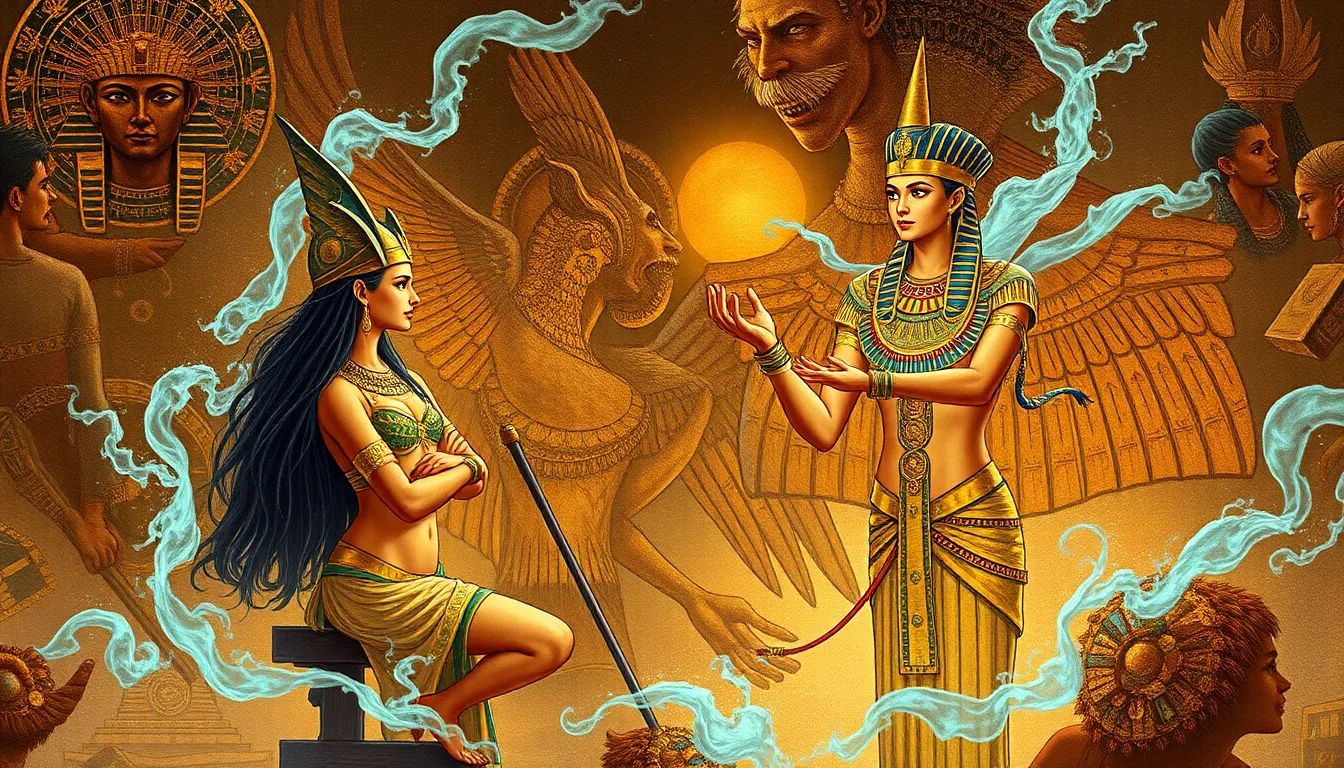The Role of Women in Egyptian Myth: Powerful Goddesses and Their Relationships
I. Introduction
Egyptian mythology is a rich tapestry of stories, deities, and beliefs that shaped the ancient civilization of Egypt. Central to these narratives are the powerful goddesses, who played critical roles in the lives of the Egyptians and their understanding of the universe. Women in Egyptian mythology are not merely supporting characters; they are often depicted as potent forces of nature, embodying various aspects of life, death, love, and justice.
This article aims to explore the roles of significant goddesses in Egyptian mythology, the relationships they maintained with other deities, and how these representations reflect the broader societal views on women during ancient times.
II. The Pantheon of Egyptian Goddesses
The pantheon of Egyptian goddesses is diverse and multifaceted, each representing different dimensions of life and the cosmos. Some of the most notable goddesses include:
- Isis
- Hathor
- Sekhmet
- Ma’at
Unlike their male counterparts, who often had more straightforward roles as gods of war, the goddesses frequently embodied complex attributes, including motherhood, fertility, music, and justice. This distinction highlights the multifaceted nature of femininity as represented in the mythology.
III. Isis: The Archetype of Motherhood and Magic
Isis is one of the most revered goddesses in Egyptian mythology, known for her wisdom, magical prowess, and nurturing qualities. She is often depicted as a mother figure, symbolizing the ideal of motherhood and female strength.
Her origins trace back to the earliest forms of Egyptian religion, where she was venerated as the wife of Osiris and the mother of Horus. Her attributes include:
- Protector of children
- Goddess of magic and healing
- Symbol of resurrection and fertility
Isis’s relationships within the pantheon are significant. Her bond with Osiris, who was killed by his brother Set, demonstrates her role as a protector. She resurrected Osiris, allowing him to become the god of the afterlife, and gave birth to Horus, ensuring the continuation of their lineage and the balance of power between good and evil.
IV. Hathor: The Goddess of Love, Joy, and Music
Hathor, another prominent goddess, is celebrated as the goddess of love, joy, and music. Often depicted as a cow or a woman with cow horns, she embodies fertility and motherhood. Her worship was widespread, and she was associated with:
- Love and beauty
- Music and dance
- Motherhood and joy
Hathor’s influence extended beyond the spiritual realm into the social fabric of Egyptian life. Festivals in her honor were vibrant celebrations of music and dance, reflecting the cultural significance of joy and fertility in society. She was also seen as a protector of women and children, reinforcing her role as a nurturing deity.
V. Sekhmet: The Warrior Goddess
Sekhmet presents a contrasting aspect of femininity in Egyptian mythology. Known as the warrior goddess, she represents the fierce and protective nature of women. Her characteristics include:
- Warrior and protector
- Goddess of healing and medicine
- Symbol of destruction and vengeance
Sekhmet’s duality is significant; she is both a force of destruction and a healer. Her relationship with the sun god Ra underscores her importance in the pantheon. According to myth, Ra sent her to punish humanity for their disobedience, but she later became associated with healing and medicine, illustrating the complex nature of her character and her significance in maintaining cosmic order.
VI. Ma’at: The Goddess of Truth and Justice
Ma’at is a central figure in Egyptian mythology, representing truth, balance, and cosmic order. She is often depicted with an ostrich feather, symbolizing the principle of truth.
The concept of Ma’at was vital for Egyptian society, as it governed the moral and ethical behavior of individuals and the leadership of pharaohs. Her role includes:
- Maintaining cosmic order
- Guiding the pharaohs in their duties
- Ensuring justice in the afterlife
Ma’at’s interactions with pharaohs were crucial; they were expected to uphold her principles to maintain the stability of the kingdom. In the afterlife, the deceased were judged against her feather, determining their fate based on their adherence to her ideals.
VII. The Interconnectedness of Goddess Relationships
The relationships among the Egyptian goddesses and their interactions with male gods illustrate the dynamics of power and authority in mythology. These relationships often reflect the complexities of female identity and strength in a patriarchal society.
Key dynamics include:
- The supportive yet powerful role of goddesses like Isis and Hathor in relation to male gods.
- The rivalry and cooperation among goddesses that shaped their narratives, such as Sekhmet’s fierce nature contrasted with Ma’at’s ideals of justice.
- The influence of these relationships on societal views of women, highlighting their roles as both nurturers and warriors.
The portrayal of female power and authority through these relationships emphasizes the importance of women in the mythological narratives and the society that created them.
VIII. Conclusion
In conclusion, the roles of goddesses in Egyptian mythology are both multifaceted and significant. From the nurturing qualities of Isis to the fierce warrior spirit of Sekhmet, each goddess represents different aspects of life and the human experience. Their relationships with each other and with male deities showcase the complexity of femininity in ancient Egypt and the influential roles women held in both mythology and society.
The impact of these female deities continues to resonate in modern culture and religion, reflecting an evolution of women’s roles that began thousands of years ago. Understanding the power and significance of these goddesses allows us to appreciate the depth and richness of Egyptian mythology and the enduring legacy of its female figures.




